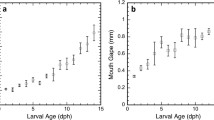Abstract
We investigated the interacting effects of copepod body size and the presence or absence of egg masses on the risk of predation by a visual predator. We conducted selection experiments involving three-spined sticklebacks (Gasterosteus aculeatus) and copepods ranging in body mass from 0.5 to 740 µg C: Oithona similis, Corycaeus anglicus, Pseudocalanus newmani, P. moultoni, Pseudodiaptomus marinus, and Paraeuchaeta elongata. We found that sticklebacks selected ovigerous females of the two smallest-bodied species of copepods (Oithona similis and Corycaeus anglicus). In contrast, the fish showed no significant selection for ovigerous females of the remaining, larger-bodied species. Unexpectedly, egg mass position (i.e., in a ventral, dorsal or lateral location on the urosome) appeared to influence predation risk more than did body size, resulting in higher predation risk for the cyclopoid and poecilostomatoid species than for the calanoid species we tested. Although the sticklebacks showed no statistically significant preference for ovigerous females of any of the four calanoid species, for each species the overall proportion of ovigerous females ingested was slightly greater than 0.50. Thus, whether body size influences the susceptibility of egg-brooding calanoid copepods to predation remains an open question.
Similar content being viewed by others
Author information
Authors and Affiliations
Additional information
Received: 24 August 1998 / Accepted: 6 July 1999
Rights and permissions
About this article
Cite this article
Logerwell, E., Ohman, M. Egg-brooding, body size and predation risk in planktonic marine copepods. Oecologia 121, 426–431 (1999). https://doi.org/10.1007/s004420050948
Issue Date:
DOI: https://doi.org/10.1007/s004420050948




